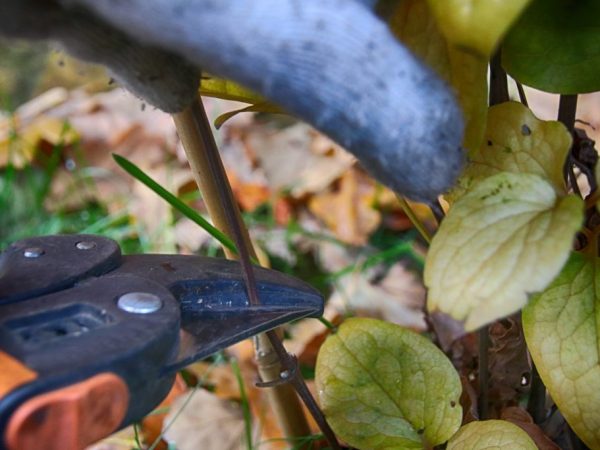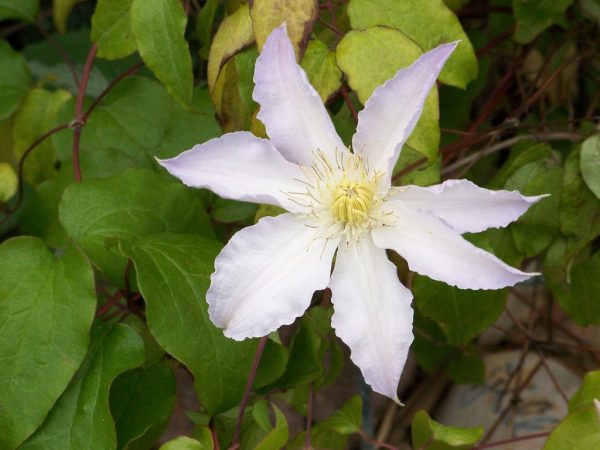Pruning clematis in the fall
Of the flowering garden plants, clematis is very popular. In order for it to bloom profusely, good care is required. Correct pruning of clematis in the fall is especially important. It is this process that regulates the growth of the plant, its development and the abundance of flowering.

Pruning clematis in the fall
Formative trim value
Clematis is pruned in the fall, this is done in the first year of the plant's life. So the plant is forced to bloom and give new shoots. Vines after the procedure branch better and look healthy.
Formation is carried out both in spring and autumn. Each period has its own pros and cons.
After spring pruning, long achenes remain, which do not look very beautiful. It is impossible to get rid of them before the fall.
Formative pruning of clematis is carried out in the fall, in November, it gives the shoots the opportunity to develop. Such pruning times are good for central Russia. The procedure will not lead to early emergence of new buds, and frost will not be able to destroy young shoots.
Types of clematis
According to the methods of formation, the bushes are divided into 3 groups. This division is due to the following factors:
- the kind of a bush;
- plant variety;
- flowering time.
The formation of clematis is done depending on the category to which it belongs:
- flowering on the shoots of this year;
- flowering on last year's shoots;
- flowering on last year's pruned shoots.
There are varieties that form buds and flowers on last year's shoots. Therefore, the procedure carried out at a later date, when there are already shoots and buds, leads to the fact that flowering does not occur.
If the procedure is carried out in May, then these species have time for kidney formation.
Pruning clematis in the fall in some varieties is done only for the beautiful design of the bush.
If the bush blooms in July, then powerful shoots are formed every year. Flowers are located on them. Such species are greatly shortened in the fall, the bush is well ventilated during flowering and looks beautiful.
Formation methods
All plants are divided into 3 main groups according to the way they are formed. Each group needs a different procedure. Clematis is pruned in the fall like this:
- the plant is not pruned at all or only immature parts are removed from the shoots;
- cut off half;
- cut at the root.
Before starting the procedure, it is important to have your kidneys examined. If new large buds have already appeared in the sinuses, you cannot leave long shoots.
It is always best to shorten young plants. Then their flowering will be more lush and long lasting.
First group

Some types of flowers do not require shaping
The princes winter well in their original form. They survive frosts safely and therefore do not touch their scissors. On Zhakmanah, Intergrifolia and Viticella, flowers appear on the shoots of this year. Therefore, all last year's shoots are cut off. In warm climates, they bloom in early spring and retain their lush crown until the end of September.
Hybrids usually bloom late.Such species include the well-known Montana, which blooms on old shoots, while new ones remain empty. This bush grows and very quickly braids around the supports or arbors. The species is picky about climatic conditions and does not tolerate severe frosts. The entire above-ground part may perish. This variety does not require shaping.
Second group
In the second group, the first flowers appear on last year's shoots, but quickly fall off. The bush blooms profusely later, when young shoots appear. The lush blooming crown lasts from July to October. Therefore, when pruning clematis in the fall, it is better to shorten or completely cut out all last year's shoots to give an incentive for the growth of new ones. For flowering in the spring, you can leave a few branches from last year so that the bush does not seem naked.
Third group
The third group includes solid and erect species. Herbaceous shoots die with the onset of cold weather. It is better to remove such species at the root and sprinkle with fallen leaves, creating a protective cushion.
Actions after trimming
Flowering is a crucial period that takes a lot of energy from plants. In order for the flower to have a good rest and be ready for a new lush flowering, it is important to properly prepare it for the winter period after the autumn formation.
For novice clematis growers, shaping is the first step towards a long winter. Then, diseased and weak shoots are removed, which can cause illness of the entire bush.
There are 2 types of shelter for the winter.
In the first case, in preparation for winter, the shoots are laid on the ground. It is better to place cut branches of vines under them or put spruce branches. If the vines are too long, they are twisted into a ring and sprinkled with humus or earth on top.
There is another option for shelter. All shoots are stacked next to each other. From above they are covered with cut branches of other trees from the garden. All this is covered by lutrasil. To prevent the material from being blown off by the wind, it is pressed down along the edges with something heavy: stones or sticks.
Conclusion
In order for the bushes to bloom profusely in the spring and before the onset of autumn, it is important to carry out the autumn shaping procedure correctly and cover them well for the winter. It is important for beginner growers to understand that the timing and methods of pruning depend on the timing of flowering. This simple secret will allow you to get beautiful bushes on the site.


